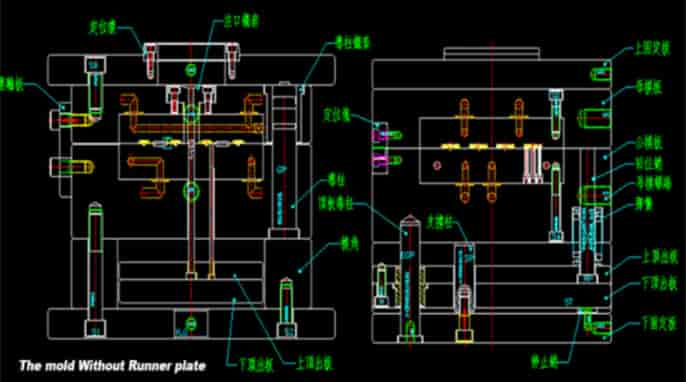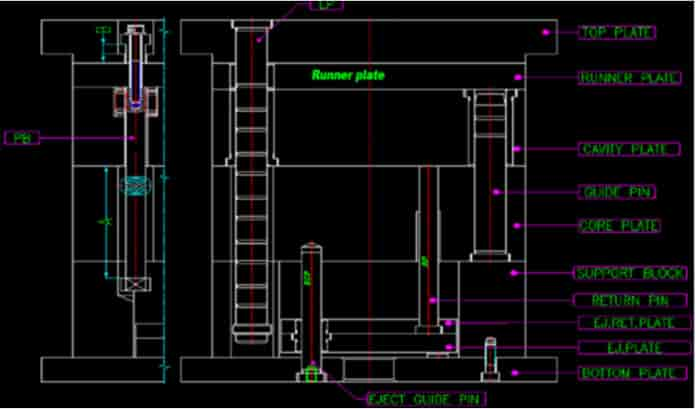Typically, the decision to choose an injection mold depends on the type of product, its design, production volume, and budget. However, even after you have all this sorted, how do you know which mold is better: mold with runner plate(2 plate) or plate mold wthout runner plate(3 plate)?
Don’t worry if you’re confused; this detailed guide will help you understand both molds’ usage, and differences.

What Is A 2 Plate Mold?
This is the most fundamental mold type, frequently used to produce inexpensive plastic goods. It has a cavity, a core, and two spits at the dividing line. It goes off into space in a single stage. The runner and gate must be positioned near the dividing line using a two-plate mold.
Consequently, when using the runner, it is important to evacuate the part, and it is necessary to break it apart individually. However, you should not use two-plate molding, even if it is a simpler and less expensive alternative that can produce high-quality goods.
How Does It Work?
When comparing 2 plate mold or 3 plate mold, it’s important to understand how both these molds work.
Now the two-plate mold is a common choice for producing inexpensive plastic components. It has a cavity and a core, separated at the parting line, and it opens using only one stage of the process.
Hence, when it comes to the structure of this mold, it is important to align the gate and the runner at the separating line. This allows the runner to come out when you eject a part while necessitating a separate procedure to break it.
After molding, the injection-molded product and the runner stay on the side that is moving. As a result, it will propel the product and the ejection system away from the same parting surface.
Later, once the mold opens, the goods are pushed away from the mold by the moveable mold side that contains the ejection system. Since a two-plate mold is straightforward and economical, you should not consider using it to make a high-precision product.
What Is A 3 Plate Mold?
The most fundamental difference between a 2 plate mold and 3 plate mold is that the latter type contains an additional runner plate. Therefore, it keeps the runner within the runner plate, and you will be free to position the runner wherever you see fit.
The position of the gate also provides the advantage of being able to place it wherever. The mold breaks apart in two distinct stages. Although the cost of the mold will increase with the presence of a runner plate, three-plate molds are the greatest option for producing precision parts of a high grade.
How Does It Work?
Initially, the core and cavity of a mold with three plates won’t become distinct when the mold opens. Therefore, the stripper plate and cavity plate should separate from one another. The stripper plate will separate the molded product from the gate material during the second step of the process.
Eventually, the core and cavity will disengage from one another to facilitate the product’s expulsion. Injection, cooling, and removal of products are the phases of the plastic injection molding process that occur in a machine with three plates.
Two separation lines and three opening sequences are present in the three-plate injection mold’s design. These opening sequences include a runner opening, a product opening, and a runner stripper plate opening. In addition, this particular mold has two separation lines; one is used to remove the product, while the other helps to remove a runner.

Conclusion: Which Mold Is Better?
To sum up, the key distinction between a 2 plate mold and a 3 plate mold is that in the former, the runner is located on either the A or B plate, which is situated on the parting line layer. You will also find it eject out by the ejector systems with the part together.
In contrast, in the three-plate mold, the runner will stick with the C plate (runner plate), and later one will be ejected by the pusher and is more complex and expensive than the two-plate mold.
Furthermore, the two-plate mold is far simpler and less expensive. On the other hand, professionals rarely propose three plate molds because they have several downsides and are significantly more complex in structure, with a greater scrap rate.
When deciding between 2 plate mold or 3 plate mold, remember that the latter lacks stability due to a complex mechanism and requires a longer cycle time. You’ll also need a larger injection molding machine to use these molds because the run distance is longer than with a two-plate mold.
For more details and queries, contact our professionals at www.ppsindu.com